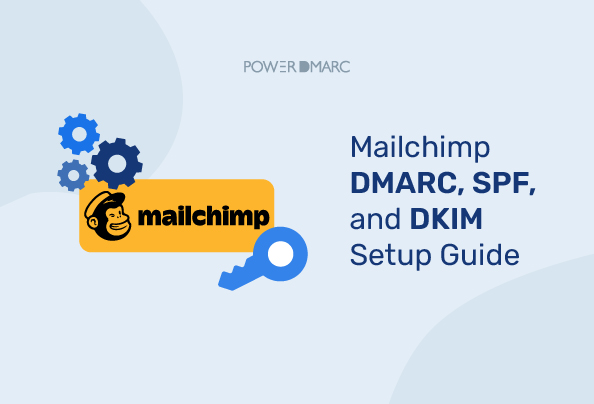Authenticating your domain name using Mailchimp DMARC, SPF, and DKIM can help you prevent unauthorized usage of your domain. This has become mandatory since February 1 2024, as unauthenticated emails can get blocked by Gmail and Yahoo inboxes.
Mailchimp Email Domain Verification
Mailchimp’s Email Domain Authentication document elucidates a few simple steps to set up domain name authentication for your registered domains on the Mailchimp portal.
To start authenticating your email domain on Mailchimp, you need to first verify your domain name. To do so, follow these steps:
1. Click on your profile icon and select Profile
2. Click on the Domains tab
3. On the Domains page, click on “Add & Verify Domain”
4. The “Verify a Domain” popup will appear at this moment. Enter your email address and click on Send Verification Email
5. A verification email should be sent to your address, containing a verification code. Enter the code and click Verify.
6. You will receive a successful verification status for your domain
How to Set Up Mailchimp DMARC Record?
DMARC for Mailchimp will increase the chances of your outgoing emails getting delivered to your receiver’s inbox. It will also ensure that you are playing an active role in protecting your clients against phishing attacks.
1. Create Your Mailchimp DMARC Record
Sign up with PowerDMARC to access our DMARC generator tool (it’s free!).
2. Choose Your Policy Mode
Your DMARC policy tells receivers how you want them to handle emails from your domain that fail authentication. Your receiver can either reject, quarantine, or take no action against them based on your preferences.
3. Publish Your TXT Record for DMARC Mailchimp
Finally, to Configure Mailchimp DMARC, publish the record on your DNS database. Your domain registrar can assist you in this step.
4. Check Your Mailchimp DMARC Configuration
You can verify your configuration with the help of our DMARC checker tool. This will make sure your record is error-free and implemented correctly.
5. Confirm your Mailchimp Authentication
Once you have setup your Mailchimp DMARC record, head over to Mailchimp and confirm your authentication. Your domain name should have an “Authenticated” status against it.
Steps to Set Up Mailchimp DKIM Record
Before implementing DMARC for Mailchimp, you need to configure either Mailchimp DKIM or SPF. This is a mandatory step to ensure your DMARC authentication is valid. Mailchimp requires you to verify your domain name before you proceed.
DKIM helps you prevent man-in-the-middle attackers who try to tamper with your message before it reaches the intended inbox. Let’s find out how you can enable it:
1. Click on your profile icon and select Profile
2. Click on the Domains tab
3. Click on “Start Authentication” against your domain name
4. Choose your domain provider (e.g. Google domains) from the dropdown menu
5. Click Next
6. Follow the on-screen instructions to generate your DKIM records. Depending on your domain provider, Mailchimp customizes records for your domain
7. Copy and paste these records into your DNS management console
8. Verify your Mailchimp DKIM setup using our DKIM checker tool
9. Head back to your Mailchimp portal and Click on Next
Steps to Set Up Mailchimp SPF Record
You don’t need to set up Mailchimp SPF manually. Mailchimp decided to remove their previous SPF mechanism “include:servers.mcsv.net”. As per how email marketing generally works, your outgoing emails are being sent from the 3rd party source’s domain as opposed to the original From Domain. In other words, this would typically fail SPF alignment result when the receiving mail server does its DNS query, which negates the need for adding Mailchimp to your SPF DNS record.
By doing so, Mailchimp also eliminates the additional SPF lookup count that would have been added to their domain’s SPF record.
In this case, it is essential to set up DKIM along with your DMARC configuration. Since DMARC requires either SPF or DKIM alignment to pass for emails to authenticate, even if SPF alignment for DMARC fails, DMARC passes based on successful DKIM alignment.
Manual Methods for MailChimp Email Domain Authentication
It is important to understand that while we have provided an automated and easier approach to setting up the MailChimp DMARC, SPF and DKIM, it can be done manually. Technical experts who are well versed in configuring email authentication protocols can manually update their DNS without using online tools. However, it does leave room for human errors and doesn’t provide effective monitoring abilities.
It’s a Wrap
Enabling Mailchimp Email Domain Authentication is not the end of the line. There are a lot of additional steps that go into ensuring that your emails are delivered properly. This includes monitoring your DMARC reports. You can configure PowerDMARC’s DMARC report analyzer for this purpose. Our simplified reports are comprehensive and human-readable, providing unparalleled visibility into your email channels. Instead of a dedicated inbox, this is a smarter approach to analyzing reports while decluttering your inbox.
For one-on-one assistance in configuring domain name authentication for all your email vendors – contact us to speak to an expert today!
Our Content Review and Fact Checking Process
This piece of content has been written and reviewed by Cybersecurity experts. We have referred to MailChimp’s official documents for accurate information. Our experts have then followed the step by step process on the MailChimp portal to set up domain authentication.
- SMTP Yahoo Error Codes Explained - May 1, 2024
- SPF Softfail Vs Hardfail: What’s the Difference? - April 26, 2024
- FTC Reports Email is a Popular Medium for Impersonation Scams - April 16, 2024
